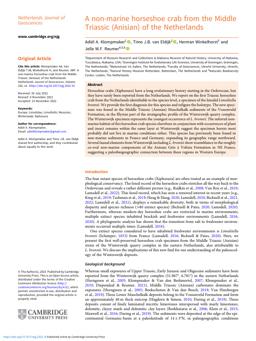2023-01-10
A non-marine horseshoe crab from the Middle Triassic (Anisian) of the Netherlands
Publication
Publication
Geologie en Mijnbouw , Volume 102 - Issue e1
Horseshoe crabs (Xiphosura) have a long evolutionary history starting in the Ordovician, but they have rarely been reported from the Netherlands. We report on the first Triassic horseshoe crab from the Netherlands identifiable to the species level, a specimen of the limulid Limulitella bronnii.We provide the first diagnosis for this species and refigure the holotype. The new specimen was found in the Middle Triassic (Anisian) Muschelkalk sediments of the Vossenveld Formation, in the Illyrian part of the stratigraphic profile of the Winterswijk quarry complex. The Winterswijk specimen represents the youngest occurrence of L. bronnii. The inferred nonmarine habitat of this horseshoe crab species elsewhere in conjunction with occurrences of plant and insect remains within the same layer at Winterswijk suggest the specimen herein most probably did not live in marine conditions either. This species has previously been found in non-marine sediments in France and Germany, expanding its geographic range northward. Several faunal elements from Winterswijk including L. bronnii show resemblance to the roughly co-eval non-marine components of the Anisian Grès à Voltzia Formation in NE France, suggesting a paleobiogeographic connection between these regions in Western Europe.
| Additional Metadata | |
|---|---|
| , , , , , | |
| doi.org/10.1017/njg.2022.16 | |
| Geologie en Mijnbouw | |
| Released under the CC-BY 4.0 ("Attribution 4.0 International") License | |
| Organisation | Staff publications |
|
Klompmaker, Adiël A., van Eldijk, Timo J.B., Winkelhorst, Herman, & Reumer, J. (2023). A non-marine horseshoe crab from the Middle Triassic (Anisian) of the Netherlands. Geologie en Mijnbouw, 102(e1). doi:10.1017/njg.2022.16 |
|
